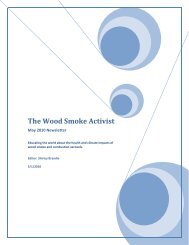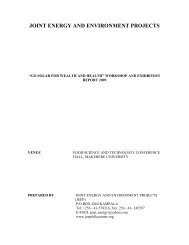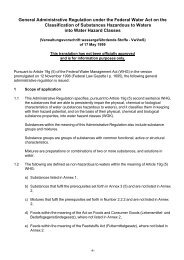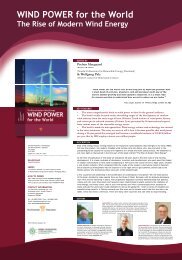You also want an ePaper? Increase the reach of your titles
YUMPU automatically turns print PDFs into web optimized ePapers that Google loves.
gas yielD of Different<br />
biomasses<br />
As mentioned earlier, all organic matter, with<br />
the exception of lignin, can be decomposed<br />
anaerobically to produce biogas, although the<br />
time taken to do so differs greatly. How long<br />
it takes depends on the composition of the<br />
biomass – the more complicated the molecules,<br />
the longer it takes a microorganism to break it<br />
down.<br />
Sometimes a biomass consists of a number<br />
of different substances that have an impact on<br />
the gas yield. Figure 16 shows the biogas and<br />
methane yield when carbohydrates (cellulose),<br />
proteins and fats are completely digested. The<br />
table shows that the gas yield is about twice as<br />
high for fat as for protein and carbohydrate.<br />
The table also shows that the composition<br />
of a biomass – the ratios between carbohydrate,<br />
protein and fat – has an effect on how much<br />
methane the biomass contains and therefore<br />
on its calorific value. The methane content<br />
from a biogas plant where the input is mainly<br />
animal manure is typically around 65%, which<br />
Organic Gas yield, STP 1) CH 4<br />
substance Process ml biogas/g ml CH 4/g %<br />
Cellulose (C 6H 10O 5)n + nH 2O 3nCH 4 + 3nCO 2 830 415 50.0<br />
Protein 2C 5H 7NO 2 + 8H 2O 5CH 4 + 3CO 2 + 2(NH 4)(HCO 3) 793 504 63.6<br />
Fat 2) C 57H 104O 6 + 28H 2O 40CH 4 + 17CO 2 1,444 1,014 70.2<br />
Substance Level of digestion, %<br />
Organic matter (VS) 60<br />
Protein 47<br />
Fatty acids, lipids 69<br />
Hemicellulose 65<br />
Cellulose 69<br />
Starch 94<br />
1<br />
is because there is some CO 2 in solution in the<br />
alkaline liquid. The methane content of landfill<br />
gas can be as low as 50%.<br />
The biogas yield of a biomass is actually<br />
quite precisely defined: the conversion of 1<br />
kg COD (that is, the amount of organic matter<br />
that consumes 1 kg O 2 at a total digestion)<br />
produces precisely 0.35 m 3 methane at normal<br />
temperature and pressure. Unfortunately, a biomass<br />
is rarely completely digested, or at least<br />
it takes a very long time and cannot be relied<br />
on in practice as the reactor size is limited<br />
and the average retention time will, therefore,<br />
also be limited. Figure 17 shows an example<br />
of the level of digestion achieved of different<br />
substances in pig slurry under normal process<br />
conditions.<br />
Extending the retention time will naturally<br />
increase the level of degradation, while a shorter<br />
retention time will result in a decrease. The<br />
last three substances in the table - the polysaccharides<br />
– are the most important for biogas<br />
production, as they are the main constituents<br />
of most biomasses.<br />
Figure 16. <strong>Biogas</strong> and methane yield at a complete digestion of carbohydrate (cellulose), protein and fat.<br />
1) STP = Standard Temperature and Pressure (0°C and 1 atm.). 2) Glycerol trioleic acid.<br />
Figure 17. Level of digestion of different substances in pig<br />
slurry. Organic matter is stated as volatile solids (VS – the<br />
organic, decomposable part of dry matter).

















